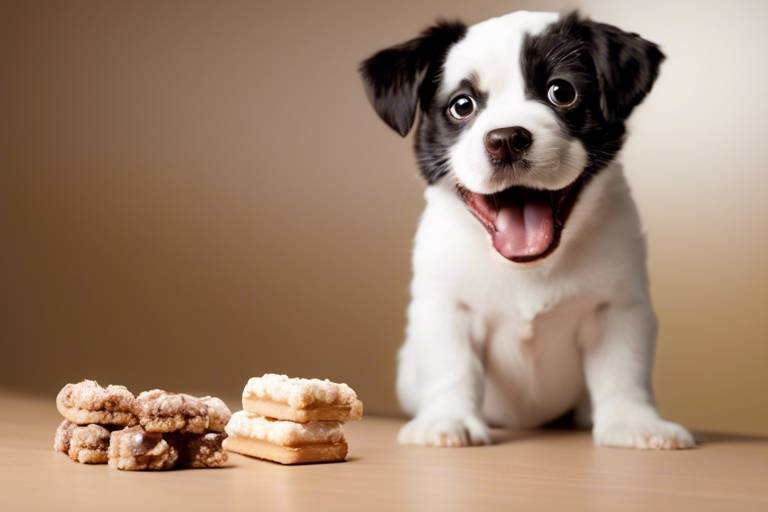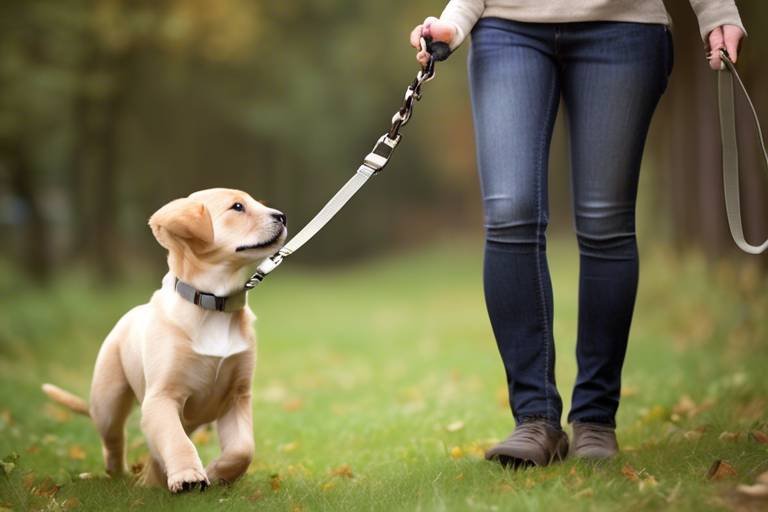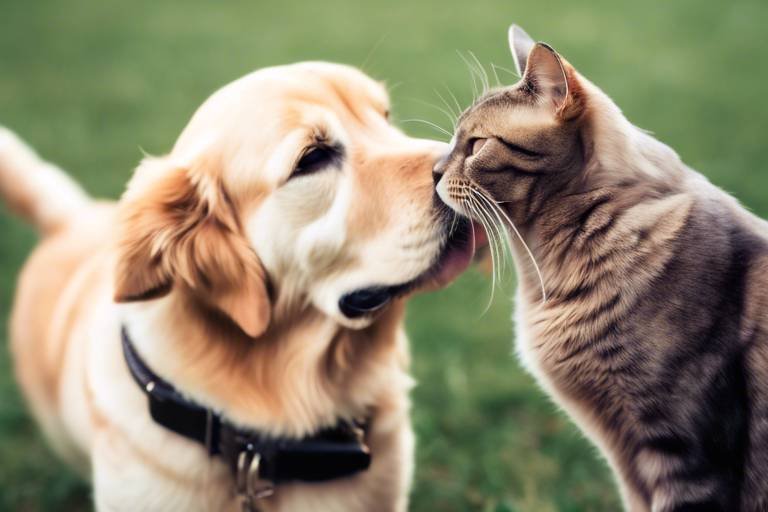How to Use Treats Effectively in Training
Training your pet can sometimes feel like navigating a maze, but the right approach can turn that maze into a fun adventure. One of the most powerful tools in your training arsenal is treats. Not just any treats, but strategically chosen ones that can enhance learning and foster a positive environment for both you and your furry friend. In this article, we will dive into how to use treats effectively in training sessions, exploring their benefits, types, and best practices. By the end, you’ll be equipped with the knowledge to transform training from a chore into a rewarding experience!
Treats serve as motivational tools in training, reinforcing positive behavior and encouraging learning. Think of them as the carrot at the end of the stick—something that keeps your pet engaged and enthusiastic. Understanding their role can help trainers maximize effectiveness and create enjoyable experiences for both the trainer and the animal. When used correctly, treats can help build a solid foundation of trust and communication, making your training sessions not just productive, but also fun!
Selecting appropriate treats is crucial for effective training. Imagine trying to motivate someone with a reward they don’t enjoy; it just wouldn’t work, right? Factors such as size, flavor, and nutritional value can impact an animal's engagement and response during training sessions. For instance, a small dog may struggle with a large treat, while a picky eater might turn their nose up at something bland. Choosing the right treats ensures they remain focused and motivated. Here are some key considerations:
- Size: Treats should be small enough to be consumed quickly, allowing for a smooth training flow.
- Flavor: Experiment with different flavors to find out what excites your pet the most.
- Nutritional Value: Opt for treats that contribute positively to your pet's diet.
Different types of treats, including soft, crunchy, and homemade options, can be used in training. Each type has its own advantages and can cater to the preferences of various animals, enhancing training success. For example:
Soft treats are often more appealing and easier to chew, making them ideal for quick rewards during training. Their palatability can help maintain an animal's attention and enthusiasm throughout the session. Plus, they can be broken into smaller pieces, which is great for frequent rewarding!
Creating homemade treats allows trainers to control ingredients and cater to specific dietary needs. This personal touch can also strengthen the bond between the trainer and the animal, enhancing the training experience. Imagine the joy on your pet’s face when they realize that the treat you’re offering is made just for them!
The timing and frequency of treat delivery are vital for effective reinforcement. Properly timed rewards can help solidify desired behaviors and improve learning outcomes during training sessions. Think of it as a well-timed surprise party; the excitement comes when it’s unexpected but perfectly executed. Remember, timing is everything!
Integrating treats into training sessions requires a balanced approach. Knowing when and how to use treats can enhance engagement while preventing over-reliance. You want your pet to learn effectively without losing motivation. It’s like teaching someone to ride a bike; you want them to feel supported without being overly dependent on training wheels.
Establishing a reward schedule helps maintain structure during training. By varying the frequency of treat rewards, trainers can keep animals engaged while promoting consistent behavior and learning over time. For instance, you might start with a treat every time your pet performs a desired behavior, then gradually reduce it to every few times as they become more proficient.
As animals progress, gradually reducing treat rewards encourages intrinsic motivation. This approach fosters independence and reinforces learned behaviors, ensuring that the animal remains responsive even without constant treat reinforcement. It’s like teaching a child to read; at first, they need guidance, but eventually, they learn to enjoy reading on their own!
1. How often should I use treats during training?
It’s best to use treats frequently at the beginning to reinforce behaviors, then gradually reduce the frequency as your pet learns.
2. Can I use regular food as treats?
Absolutely! Just make sure it’s something your pet enjoys and that it’s appropriately sized for quick consumption.
3. What if my pet isn’t motivated by treats?
Try different types of rewards, like toys or praise. Every pet is unique, and finding what motivates them can take some experimenting!

Understanding the Role of Treats
This article explores the strategic use of treats in training sessions, highlighting their benefits, types, and best practices for enhancing learning and behavior in pets and other animals.
Treats serve as motivational tools in training, reinforcing positive behavior and encouraging learning. Imagine trying to learn a new skill without any rewards—pretty dull, right? That's where treats come in! They act like little nuggets of joy that not only grab an animal's attention but also create a fun and engaging training environment. By understanding their role, trainers can maximize effectiveness, making sessions enjoyable for both the trainer and the animal.
When you think about it, treats are more than just snacks; they're a form of communication between you and your pet. Each time you offer a treat, you're sending a clear message: “Great job!” This positive reinforcement helps animals associate specific behaviors with rewards, making them more likely to repeat those behaviors in the future. It's like giving your pet a high-five every time they do something right!
Moreover, the strategic use of treats can help in building trust and bonding between the trainer and the animal. When an animal knows that good behavior leads to tasty rewards, it fosters a sense of cooperation and eagerness to learn. Think of it as a partnership; the animal is more likely to engage and participate when they know there’s a delicious payoff at the end. This bond can be crucial, especially in training scenarios where trust plays a significant role.
To make the most of treats in training, it’s essential to consider a few key factors:
- Type of Treat: Different animals have different preferences. Some might go crazy for soft treats, while others might prefer crunchy ones.
- Timing: The timing of when you give a treat can significantly impact its effectiveness. Immediate rewards after a desired behavior are often the most effective.
- Quantity: Too many treats can lead to weight gain and health issues, so moderation is key.
In summary, treats are not just about rewarding good behavior; they play a fundamental role in shaping the learning experience. By understanding their significance, trainers can create a more engaging and effective training environment, ensuring that both the animal and the trainer have a rewarding experience. So, the next time you reach for that bag of treats, remember: you’re not just feeding your pet; you’re also building a stronger bond and enhancing their learning journey!
Selecting appropriate treats is crucial for effective training. Factors such as size, flavor, and nutritional value can impact an animal's engagement and response during training sessions, ensuring they remain focused and motivated.
Different types of treats, including soft, crunchy, and homemade options, can be used in training. Each type has its own advantages and can cater to the preferences of various animals, enhancing training success.
Soft treats are often more appealing and easier to chew, making them ideal for quick rewards during training. Their palatability can help maintain an animal's attention and enthusiasm throughout the session.
Creating homemade treats allows trainers to control ingredients and cater to specific dietary needs. This personal touch can also strengthen the bond between the trainer and the animal, enhancing the training experience.
The timing and frequency of treat delivery are vital for effective reinforcement. Properly timed rewards can help solidify desired behaviors and improve learning outcomes during training sessions.
Integrating treats into training sessions requires a balanced approach. Knowing when and how to use treats can enhance engagement while preventing over-reliance, ensuring that animals learn effectively without losing motivation.
Establishing a reward schedule helps maintain structure during training. By varying the frequency of treat rewards, trainers can keep animals engaged while promoting consistent behavior and learning over time.
As animals progress, gradually reducing treat rewards encourages intrinsic motivation. This approach fosters independence and reinforces learned behaviors, ensuring that the animal remains responsive even without constant treat reinforcement.
Q: How often should I give treats during training?
A: It varies by animal and training goals, but generally, treats should be given immediately after a desired behavior to reinforce that action.
Q: Can I use regular food as treats?
A: Yes! Many pets enjoy their regular kibble or meals as treats. Just ensure they are small enough to be considered a reward and not a full meal.
Q: What if my pet isn't motivated by treats?
A: Some animals may respond better to praise, toys, or playtime as rewards. Experiment with different motivators to find what works best for your pet.

Choosing the Right Treats
When it comes to training your pet, the choice of treats can make all the difference. Selecting the right treats is not just about grabbing the first bag off the shelf; it’s about understanding what will truly motivate your furry friend. Think of treats as the currency of training—they need to be valuable enough to spark interest and enthusiasm in your pet. So, what factors should you consider?
First, consider the size of the treats. Smaller treats are often more effective because they can be consumed quickly, allowing for a smoother training session without long pauses. Imagine trying to teach a dog a new trick and having to wait for them to chew a large biscuit! It can be frustrating for both you and your pet. Instead, opt for bite-sized morsels that keep the momentum going.
Next up is the flavor. Just like humans, pets have their preferences. Some might go wild for chicken-flavored treats, while others may prefer peanut butter or even fish! It’s crucial to know what flavors excite your pet the most. A treat that your pet finds irresistible will not only enhance their engagement during training but also make the learning process a lot more enjoyable.
Another important consideration is the nutritional value of the treats. While it might be tempting to use high-calorie snacks, especially if they are your pet's favorite, it’s essential to choose options that are healthy and balanced. You wouldn’t want to reward your pet with something that could lead to health issues down the line. Look for treats that are low in calories but high in flavor, ensuring that your pet is motivated without compromising their health.
To help you visualize the differences, here’s a simple table summarizing the key factors to consider when choosing treats:
| Factor | Consideration |
|---|---|
| Size | Choose small, bite-sized treats for quick rewards. |
| Flavor | Select flavors that your pet loves to keep them engaged. |
| Nutritional Value | Opt for healthy treats that support your pet's overall well-being. |
Lastly, remember that variety is the spice of life! Just as we enjoy a range of flavors in our meals, pets can benefit from a mix of treats. This not only keeps them excited about training but also allows you to discover what they truly love. Mixing up the treats can prevent them from becoming bored and losing interest in training sessions. So, stock up on different types and flavors to keep the excitement alive!
Types of Treats
When it comes to training our furry friends, the we choose can make a world of difference. Just like us, animals have their preferences, and understanding these can significantly enhance their training experience. Some pets might go crazy for soft treats, while others might prefer something crunchy. Let’s dive into the various types of treats available and how they can be utilized effectively in training sessions.
First up, we have soft treats. These little nuggets of joy are often more appealing to pets, especially during training when quick rewards are necessary. Their chewiness means that pets can gobble them up quickly, allowing for a seamless flow in training sessions. Imagine trying to teach your dog a new trick; you want them to stay focused and engaged. Soft treats can be a game-changer here, keeping their attention locked on you and the task at hand.
Next, we have crunchy treats. These are not just delightful for pets but also provide an auditory feedback that can be satisfying for both the trainer and the animal. The crunching sound can signal to the pet that they've done something right, reinforcing their behavior. Think of it as a little cheerleading session every time they take a bite! However, it’s essential to consider the size of these treats; they should be small enough to prevent choking and to allow for quick rewards.
Another exciting option is homemade treats. Making your own treats can be a fun and rewarding experience, allowing you to control what goes into them. This is particularly beneficial for pets with specific dietary needs or allergies. Plus, there’s something special about giving your pet a treat that you’ve made yourself. It can strengthen the bond between you and your animal, making training sessions even more meaningful. A simple recipe might include ingredients like peanut butter, oats, and pumpkin puree, which are not only tasty but also nutritious!
Lastly, let’s not forget about training treats specifically designed for this purpose. These treats are often formulated to be low in calories, ensuring that your pet doesn’t gain unwanted weight during training. They come in various flavors and textures, catering to the diverse tastes of different animals. When selecting training treats, look for options that are high in protein and low in fillers, so you’re giving your pet the best possible reward.
In conclusion, the type of treat you choose can significantly impact your training sessions. Whether you opt for soft, crunchy, homemade, or specially formulated training treats, the key is to keep your pet engaged and motivated. Remember, the goal is to create a positive and enjoyable learning environment. So, experiment with different types of treats to find what works best for your furry friend!
- What are the best treats for training? Soft, high-value treats are generally the best for training as they are easy to chew and can keep your pet engaged.
- Can I use my pet's regular food as treats? Yes, you can use your pet's regular kibble as treats, but make sure to keep the training sessions exciting with occasional high-value rewards.
- How often should I give treats during training? It's best to give treats immediately after your pet performs the desired behavior to reinforce that action effectively.
- Are homemade treats better than store-bought? Homemade treats allow you to control ingredients and cater to dietary needs, making them a great option if you have the time to prepare them.
Soft Treats
When it comes to training our furry friends, are like that secret ingredient in a recipe that takes the dish from good to absolutely delicious. These treats are not only appealing but also incredibly practical for training sessions. Imagine trying to teach your dog a new trick while they’re struggling to chew on a hard biscuit—frustrating, right? Soft treats, on the other hand, are easy to chew and digest, making them perfect for quick rewards that keep the momentum of training going strong.
One of the biggest advantages of using soft treats is their palatability. Dogs and other pets often find these treats irresistible, which means they’re more likely to pay attention and respond positively during training. Think of it this way: if you were offered a delicious slice of cake versus a dry cracker as a reward for completing a task, which one would you prefer? Exactly! The same principle applies to our pets. When they receive a soft, tasty treat, their enthusiasm for learning skyrockets.
Moreover, soft treats can be easily broken into smaller pieces, allowing trainers to adjust the reward size based on the complexity of the task at hand. For instance, if your pet successfully performs a simple command, you could give them a larger piece, but for more challenging tricks, a tiny morsel might suffice. This flexibility not only helps in managing calorie intake but also keeps the training sessions exciting and varied.
Another fantastic aspect of soft treats is their versatility. They come in a variety of flavors, from chicken to peanut butter, catering to the unique tastes of different animals. This means you can experiment with different flavors to discover what your pet loves most. Additionally, many brands offer soft treats that are formulated to be low in calories or made from natural ingredients, making them a healthy choice for training. Here’s a quick comparison table to illustrate some popular soft treat options:
| Treat Type | Flavor | Calories per Treat | Special Features |
|---|---|---|---|
| Chicken Soft Bites | Chicken | 5 | High protein, grain-free |
| Peanut Butter Chews | Peanut Butter | 4 | Made with natural ingredients |
| Salmon Soft Treats | Salmon | 6 | Omega-3 enriched |
In conclusion, incorporating soft treats into your training sessions can significantly enhance the learning experience for your pet. Their appealing texture and taste not only keep your pet engaged but also make the training process more enjoyable for both of you. So, the next time you gear up for a training session, consider reaching for those soft treats—they might just be the game-changer you need!
- What are the best soft treats for training? The best soft treats are those that your pet finds most appealing. Look for options that are low in calories and made from natural ingredients.
- Can I use soft treats for all types of pets? Yes! Soft treats can be used for dogs, cats, and even some small animals, but always ensure they are formulated for the specific type of pet.
- How many treats should I give during a training session? It's best to keep treats to a minimum, using them as rewards for successful commands. Adjust the quantity based on the task's difficulty and your pet's dietary needs.
Homemade Treats
Creating for your pets can be one of the most rewarding experiences in training. Not only do you have full control over the ingredients, ensuring that your furry friend is eating healthy, but you also get to tailor the flavors and textures to suit their unique tastes. Imagine the joy on your pet's face when they get a treat made just for them! Plus, the process of making these treats can be a fun bonding activity that strengthens your relationship with your animal.
When it comes to , the possibilities are endless! You can experiment with a variety of ingredients that are both nutritious and delicious. For instance, common ingredients like pumpkin, peanut butter, and oats are not only safe for most pets but also quite appealing. Here’s a simple recipe to get you started:
Peanut Butter & Pumpkin Dog Treats Ingredients: - 1 cup of whole wheat flour - 1/2 cup of pumpkin puree - 1/2 cup of peanut butter (ensure it's xylitol-free) - 1 egg - 1/4 cup of water (as needed) Instructions: 1. Preheat your oven to 350°F (175°C). 2. Mix all ingredients in a bowl until a dough forms. 3. Roll out the dough and cut it into shapes. 4. Place on a baking sheet and bake for 20-25 minutes. 5. Let cool before serving.
This simple recipe not only provides a tasty reward for your pet but also allows you to control what goes into their bodies. By making these treats at home, you can avoid the preservatives and additives often found in commercial products. Plus, you can make them in bulk and store them for later use. Just be sure to keep them in an airtight container to maintain freshness!
It's essential to remember that while treats are a fantastic tool for training, moderation is key. Too many treats, even if they're homemade, can lead to weight gain and other health issues. As a rule of thumb, treats should only make up about 10% of your pet's daily caloric intake. This way, your training sessions will remain effective, and your pet will stay healthy and happy.
Lastly, involve your pet in the process! Let them sniff around the kitchen as you prepare their treats. It adds an element of excitement and anticipation, making them even more eager to learn and perform during training sessions. Homemade treats are not just food; they are a form of love and care that can significantly enhance your training experience.
- What ingredients should I avoid when making homemade treats?
Be cautious of ingredients like chocolate, onions, garlic, grapes, and raisins, as they can be toxic to pets.
- How long do homemade treats last?
Homemade treats typically last about 1-2 weeks when stored in an airtight container at room temperature. For longer storage, consider freezing them.
- Can I use human food ingredients for pet treats?
Yes, many human food ingredients are safe for pets, but always check for pet-friendly options and avoid harmful foods.
Timing and Frequency of Treats
When it comes to training our furry friends, timing and frequency of treats play an essential role in reinforcing positive behavior. Imagine you're at a concert, and the band plays your favorite song at just the right moment; it makes the experience unforgettable, right? Similarly, when you reward your pet with a treat immediately after they perform the desired action, it creates a strong connection in their mind between the behavior and the reward. This instant gratification is crucial for effective learning.
However, it's not just about showering your pet with treats at random intervals. The frequency of these rewards should be carefully considered. If you offer treats too often, your pet may become desensitized to them, leading to a lack of motivation. On the other hand, if treats are given too sparingly, your pet may not associate the behavior with the reward effectively. Finding the right balance is key!
One effective method is to use a variable reinforcement schedule, which means changing the frequency of treats based on your pet's progress. For example, you might reward your pet with a treat every time they sit on command at first, then transition to rewarding them every other time, and eventually only rewarding them after a few successful commands. This approach keeps your pet engaged and excited about the training process.
To illustrate this concept, consider the following table that outlines a simple reward schedule:
| Stage of Training | Frequency of Treats | Example |
|---|---|---|
| Initial Training | Every time | Reward every time they sit |
| Intermediate Training | Every other time | Reward every second successful sit |
| Advanced Training | Randomly | Reward after a few successful commands |
Additionally, consider the timing of your treats. It’s best to deliver the treat immediately after the desired behavior occurs. This immediate reinforcement helps your pet make the connection between their action and the reward. If there's a delay, your pet may not understand what behavior they are being rewarded for, which can lead to confusion and frustration.
In summary, mastering the timing and frequency of treats can significantly enhance your training sessions. It’s all about creating that perfect moment when your pet feels rewarded and motivated to learn. Remember, training should be a fun and rewarding experience for both you and your pet, so keep it engaging and enjoyable!
- How often should I give treats during training? The frequency of treats should vary based on your pet's progress. Start with frequent rewards and gradually reduce them as your pet learns.
- Can I use regular food as treats? Yes, you can use your pet's regular food as treats, but make sure they are small and appealing enough to keep their interest.
- What if my pet loses interest in treats? Try changing the type of treat or using different rewards like praise or playtime to keep them engaged.

Incorporating Treats into Training Sessions
Integrating treats into training sessions isn't just about tossing a morsel to your pet every time they perform a trick; it's an art that can significantly enhance the learning experience for both the trainer and the animal. The key is to find a balance that keeps your furry friend engaged without creating a dependency on treats. Think of it as seasoning a dish; too much can overpower the flavors, while just the right amount can elevate the entire experience. So, how do we strike that perfect balance?
First, it’s important to understand the context of the training session. Are you teaching a new command, or reinforcing an old one? The timing of when you offer treats can make all the difference. For instance, if your pet successfully sits on command, rewarding them immediately with a treat reinforces that behavior. This instant gratification helps them connect the dots between their action and the reward. However, if you wait too long, they may not associate the treat with the desired behavior, leading to confusion.
Moreover, you should also consider the frequency of treat rewards. While it might be tempting to shower your pet with treats for every little success, moderation is key. You want to keep the excitement alive without making them expect a treat every single time. A good strategy is to start with a higher frequency of rewards when teaching a new behavior and then gradually taper off as your pet becomes more proficient. This method not only maintains their interest but also encourages them to work for the joy of learning rather than just for the food.
Another effective strategy is to create a reward schedule. This can be as simple as alternating between verbal praise and treats, or using a mix of high-value treats for more challenging tasks and lower-value treats for easier ones. For example, you might use a favorite chewy treat when teaching a complicated trick, while opting for regular kibble for basic commands like 'sit' or 'stay'. This keeps your pet guessing and engaged, making training sessions more dynamic.
As you progress, it’s essential to gradually reduce the number of treats given. This process encourages your pet to rely more on their intrinsic motivation to perform behaviors rather than solely on external rewards. It’s akin to teaching a child to ride a bike; at first, you hold onto the seat for support, but eventually, you let go, allowing them to gain confidence and independence. Similarly, by slowly phasing out treats, your pet learns that good behavior is rewarding in itself, which is a crucial step towards long-term obedience.
In conclusion, incorporating treats into training sessions requires a thoughtful approach. By understanding the timing, frequency, and type of treats used, trainers can create a positive and effective learning environment. Remember, the goal is not just to train your pet but to build a lasting bond through shared experiences. So, grab those treats, and let the training adventures begin!
- How often should I reward my pet with treats during training? It's best to start with frequent rewards for new commands and gradually reduce them as your pet becomes more familiar with the behavior.
- Can I use my pet's regular food as treats? Absolutely! Using regular food can be effective, especially for basic commands. Just ensure it's something your pet enjoys.
- What should I do if my pet loses interest in treats? Try switching up the types of treats you use. Experiment with different flavors, textures, or even homemade options to reignite their enthusiasm.
Creating a Reward Schedule
This article explores the strategic use of treats in training sessions, highlighting their benefits, types, and best practices for enhancing learning and behavior in pets and other animals.
Treats serve as motivational tools in training, reinforcing positive behavior and encouraging learning. Understanding their role can help trainers maximize effectiveness and create enjoyable experiences for both the trainer and the animal.
Selecting appropriate treats is crucial for effective training. Factors such as size, flavor, and nutritional value can impact an animal's engagement and response during training sessions, ensuring they remain focused and motivated.
Different types of treats, including soft, crunchy, and homemade options, can be used in training. Each type has its own advantages and can cater to the preferences of various animals, enhancing training success.
Soft treats are often more appealing and easier to chew, making them ideal for quick rewards during training. Their palatability can help maintain an animal's attention and enthusiasm throughout the session.
Creating homemade treats allows trainers to control ingredients and cater to specific dietary needs. This personal touch can also strengthen the bond between the trainer and the animal, enhancing the training experience.
The timing and frequency of treat delivery are vital for effective reinforcement. Properly timed rewards can help solidify desired behaviors and improve learning outcomes during training sessions.
Integrating treats into training sessions requires a balanced approach. Knowing when and how to use treats can enhance engagement while preventing over-reliance, ensuring that animals learn effectively without losing motivation.
Establishing a reward schedule is essential for maintaining structure during training. By implementing a systematic approach, trainers can keep animals engaged while promoting consistent behavior and learning over time. Think of it like a game where the rules keep changing, keeping your furry friend on their toes!
One effective strategy is to start with a high frequency of treats when teaching a new behavior. For example, rewarding every correct action can help the animal quickly understand what is expected. As the animal becomes more proficient, trainers can gradually reduce the frequency of rewards. This not only helps the animal learn to perform the behavior without expecting a treat each time but also fosters a sense of achievement.
Here’s a simple breakdown of how a reward schedule might look:
| Training Phase | Treat Frequency |
|---|---|
| Initial Learning | Every correct behavior |
| Intermediate Learning | Every second or third correct behavior |
| Advanced Learning | Randomly, based on performance |
This gradual reduction in treats encourages the animal to rely more on their understanding of the command rather than the treat itself. It’s like teaching a child to ride a bike with training wheels and then slowly removing them; the child learns balance and confidence without needing the support forever.
Moreover, varying the types of treats given can also keep the training sessions exciting. Imagine if every time you did something right, you received a surprise gift! This unpredictability can enhance motivation and engagement, making training a fun and rewarding experience for both the trainer and the animal.
- How often should I give treats during training? Start with frequent rewards when teaching new behaviors, and gradually reduce as the animal learns.
- Can I use regular food as treats? Yes, but make sure they are small and appealing enough to keep the animal motivated.
- What should I do if my pet loses interest in treats? Try changing the type of treat or introducing new flavors to rekindle their interest.
Gradually Reducing Treats
As your furry companion progresses in their training journey, it’s essential to gradually reduce the frequency of treat rewards. This process not only encourages your pet to rely on their own understanding of commands but also fosters a sense of independence. Think of it like teaching a child to ride a bike; initially, they need training wheels, but as they gain confidence and skill, those wheels come off. Similarly, reducing treats helps solidify the animal's learning while promoting intrinsic motivation.
One effective way to implement this gradual reduction is through a technique called variable reinforcement. This means that instead of giving a treat every single time your pet performs the desired behavior, you can start to reward them intermittently. For example, if your dog sits on command, you might give them a treat every time at first, then switch to rewarding them every other time, and eventually, only after a few successful attempts. This unpredictability can actually heighten their interest and excitement, making them more eager to perform the behavior.
Another key aspect to consider is the timing of the treats. As you begin to reduce the frequency, ensure that the rewards you do offer are given immediately after the desired behavior. This helps the animal make the connection between the action and the reward, reinforcing the behavior even when treats are less frequent. You might also want to incorporate verbal praise or physical affection as additional forms of reinforcement during this transitional phase. These alternatives not only help bridge the gap left by fewer treats but also strengthen the bond between you and your pet.
In terms of a practical approach, you can create a simple schedule to track your progress in reducing treats. Here’s a quick table to illustrate how you might structure your treat reduction:
| Week | Treat Frequency | Notes |
|---|---|---|
| 1 | Every time | Establishing behavior |
| 2 | Every other time | Introducing variable reinforcement |
| 3 | Every third time | Encouraging independence |
| 4 | Occasionally | Fostering intrinsic motivation |
By following this structured approach, you can effectively guide your pet towards becoming more self-reliant while still enjoying the occasional reward. Remember, the goal is not to eliminate treats entirely but to create a balanced training environment where your pet feels confident and motivated to learn. With patience and consistency, you’ll find that your animal not only retains the learned behaviors but also becomes more engaged and enthusiastic about training sessions.
- How long should I use treats in training? Treats should be used as long as they motivate your pet, but gradually reducing them over time is key to fostering independence.
- What if my pet loses interest when I reduce treats? If your pet seems less motivated, consider increasing the value of the treats or incorporating other forms of praise, like verbal encouragement or playtime.
- Can I use regular food as treats? Absolutely! Just make sure they are small and appealing to keep your pet engaged during training.
Frequently Asked Questions
- What types of treats are best for training?
When it comes to training, soft treats are often the most effective because they are easy to chew and quickly consumed, keeping the training session flowing smoothly. Crunchy treats can also work well, but they might take longer to eat. Additionally, homemade treats allow you to control the ingredients and cater to your pet's specific dietary needs, making them a great option!
- How should I time the delivery of treats?
Timing is everything! You want to deliver the treat immediately after your pet exhibits the desired behavior. This helps them make the connection between their action and the reward. Think of it like a lightbulb moment for your pet; the quicker the reward, the brighter the light!
- Can I use treats to train older pets?
Absolutely! Treats can be a fantastic motivator for pets of any age. In fact, older pets may appreciate the extra incentive even more. Just be mindful of their dietary restrictions and adjust the type and amount of treats accordingly to keep them healthy while training.
- How often should I give treats during training?
It’s best to start with frequent rewards, especially for new behaviors. As your pet learns and becomes more consistent, you can gradually reduce the frequency of treats. Think of it like a game of hide and seek; the excitement builds when they know a reward is coming, but they also learn to enjoy the game without always needing the prize!
- What if my pet becomes too reliant on treats?
This is a common concern! To prevent over-reliance, you can gradually reduce the number of treats given while still offering praise and affection. This way, your pet learns that they can still earn your approval and love without always getting a treat. It's like teaching them to enjoy the journey, not just the destination!
- Are there any treats I should avoid?
Yes, it's important to avoid treats that are high in sugar, artificial ingredients, or unhealthy fats. Always check the ingredient list and opt for treats that are nutritionally balanced. Remember, just like us, pets need to eat healthy to stay happy and energetic!
- Can I use treats for more than just obedience training?
Definitely! Treats can be used for various types of training, including trick training, socialization, and even behavior modification. They can help create positive associations in different situations, making them versatile tools in any trainer's toolkit!



















